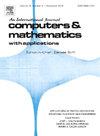热弹性固体热断裂的 PFM 能量一致性原理及其在基于自适应网格技术的裂纹增长热响应建模中的应用
IF 2.9
2区 数学
Q1 MATHEMATICS, APPLIED
引用次数: 0
摘要
研究裂纹生长引起的裂纹尖端热响应对研究材料行为非常重要。实际上,裂纹尖端的热响应是由机械耗散能量特性产生的,例如粘弹性固体中的粘性能量耗散。因此,我们提出了热粘弹性固体中裂纹扩展的 PFM,并演示了几个数值实例。我们目前的模型是由带有 Ambrosio-Tortorelli 正则化的 Francfort-Marigo 能量和热能导出的。我们的研究旨在利用所提出的模型对裂缝生长引起的材料热响应进行数值研究。在数值方法中,我们采用了自适应有限元方法,因为网格需要足够精细才能捕捉到损伤变量 z。我们展示了几个有趣的数值示例,如非等温和绝热过程中的模式 I 裂纹扩展和标量模式 III 裂纹扩展。数值实验证明,所提出的模型能够捕捉裂纹尖端周围的温度上升,这与文献中实验室实验的观点一致。本文章由计算机程序翻译,如有差异,请以英文原文为准。
On energy-consistency principle of PFM for thermal fracturing in thermoviscoelasticity solids and its application for modeling thermal response due to crack growth based on adaptive mesh technique
The study of thermal response in the crack tip due to crack growth is very important to study the material behavior. Actually, the thermal response in the crack tip is generated by the mechanical dissipation energy properties, e.g., the viscous energy dissipation in viscoelasticity solids. Therefore, we proposed the PFM for crack propagation in thermoviscoelasticity solids and demonstrated several numerical examples. Our present model is derived from the Francfort–Marigo energy with the Ambrosio–Tortorelli regularization, and thermal energy. Our study aims to numerically investigate the thermal response in materials due to crack growth using the proposed model. In the numerical method, we apply the adaptive finite element method because the mesh needs to be fine enough to capture the damage variable z. Several interesting numerical examples are demonstrated, such as Mode I crack propagation and scalar Mode III crack propagation in non-isothermal and adiabatic processes. Numerical experiments demonstrate the capability of the proposed model to capture the temperature increasing around crack tips which is consistent with the viewpoint of laboratory experiments in the literature.
求助全文
通过发布文献求助,成功后即可免费获取论文全文。
去求助
来源期刊

Computers & Mathematics with Applications
工程技术-计算机:跨学科应用
CiteScore
5.10
自引率
10.30%
发文量
396
审稿时长
9.9 weeks
期刊介绍:
Computers & Mathematics with Applications provides a medium of exchange for those engaged in fields contributing to building successful simulations for science and engineering using Partial Differential Equations (PDEs).
 求助内容:
求助内容: 应助结果提醒方式:
应助结果提醒方式:


